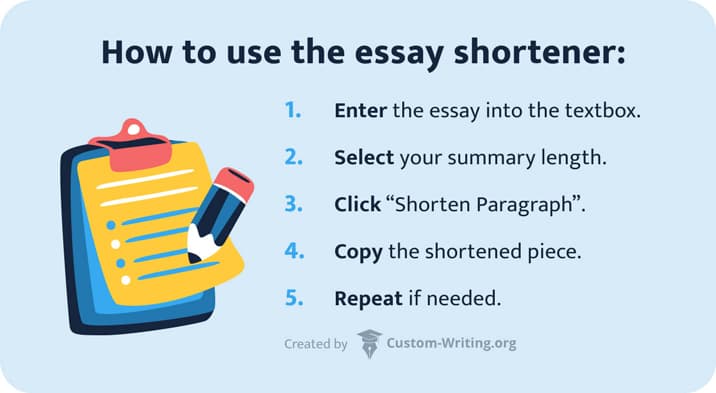🔢 How This Essay Shortener Works
To shorten a paragraph or essay using this tool, you need to perform these 5 steps:
- Enter the essay into the textbox; make sure it isn’t longer than 17000 characters.
- Select the desired length of the result.
- Click on “Shorten Paragraph” and wait for several seconds.
- Copy the shortened piece and paste it into the document.
- Repeat as often as needed.
🎁 4 Benefits of the Paragraph Shortener
| 🎓 Smart | Designed primarily for academic writing purposes. |
|---|---|
| 🕹 Tunable | Enables you to choose the exact length of your synopsis. |
| ⭐️ Versatile | Shortens standalone paragraphs and entire essays. |
| 🔍 Focused | Keeps the most relevant points of your paragraphs. |
📝 3 Reasons to Use This Essay & Paragraph Shortener
This AI-enhanced essay shortener will help students, researchers, and content writers. The tool will enhance the clarity of your writing with a couple of clicks.

Let's take a look at what you can do using this online instrument.
-
Enhance the clarity of your shortened paragraphs.
Have you ever invested your time and effort into writing an essay, only to find it overly detailed and not readable enough? Such a situation is common when one is working on a complex topic. Custom Writing's paragraph shortener is here to help! The online tool was designed to condense an essay or any other written piece into a short and clear version while keeping all the essential details.
-
Adjust your essays to the requirements.
Imagine getting so engrossed in working on an essay or another assignment that you lose track of time. Just a couple of minutes before the deadline, you realize that the text is far longer than required. “Shorten my essay” tool is the solution! It will quickly and efficiently crop your paragraph or entire paper, adjusting it to the requirements. Just indicate the desired length and enjoy the result.
-
Edit your paragraphs and essays.
We’ve recently enhanced our tool to not only shorten a paragraph or essay to the necessary length but also rephrase awkward and incorrect pieces, making your text smoother and more enjoyable to read. That's especially valuable when you lack time and don't want to use additional tools to edit your text.
Updated: